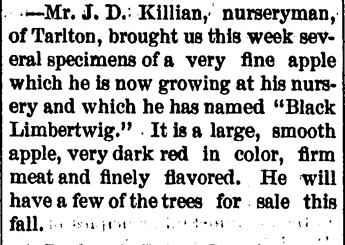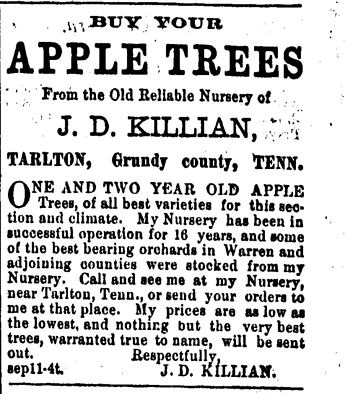Am interested in finding out more on all the Black Limbertwig strains from Dan Bussey’s list, does anyone know of anyone growing more than just the “Black” strain? I am also wondering if the Black Watts strain is the Watts Limbertwig just minus the Black in the name?
I bet Roy Joyner has some ideas about this. Or Tom Brown.
I was almost late in posting about the grafts! I have had both sides of the spectrum in growth! Some of them grew very well and others not so much. I forget now which grew the best and which ones were the slowest. of course this probably has many variables, some were on rootstock, some grafted on to different trees of different size, some of the grafts might not have took as good this first year and may take another year or so to really take off. I will try to see what they do in this coming growing year and take note of them again.
This was posted on FB by sc.edu professor David Shields. I didn’t spot him as being a member here and also didn’t find any mention of the J. D. Killian he talks about. Seemed worthy for this topic though, origins of Black Limbertwig.
The true story of the origin of the Black Limbertwig Apple
The limbertwig apples are an old and diverse family, most of which share two qualities, a “weeping habit”–that is, the slender branches arc downward, particularly when laden with apples–and a distinctive flavor–musky, smokey, and harmoniously sweet. The earliest recorded member of the limbertwig clan in America was the Red, the sweetest of all libertwigs, which the Prince Nursery in New York carried as early as 1847. The streaky yellow-red Royal Limbertwig was grown by P J Berkmans at Fruitlands Nursery in Augusta GA in the late antebellum period. Sometime in the mid-19th century orchardists in the southern Appalachian region began growing limbertwigs intensively and taking up seedling varieties (some estimate that there are 50 distinct strains in 2022). But there were about five that gained particular fame. One of them, the Black Limbertwig, was valued for being “a large, smooth apple, very dark red in color, firm meat and finely flavored.” It has yellow flesh. It became one of the mosts revered of the “winter apples”–fruit with keeping quality that kept its pungent fresh flavor until Spring. It also became an important cider apple.
Creighton Leigh Calhoun, the chronicler of OLD SOUTHERN APPLES, found little information on its origins, only noting that it came before and received the recognition of the Georgia Horiticultural Society in 1914. Hence some websites dealing in heirloom apples list it as a Georgia Apple. It is not. An article in the McMinnville TN Southern Standard of October 2, 1886 announced the moment when Black Limbertwig first came on the market.
Black Limbertwig was a seedling offshoot of the old Red Libertwig developed by J. D. Killian of Tarlton, Grundy County, TN. Killian’s “Old Reliable Nursery” had opened in 1868, specialing in apples that would flourish in the region halfway between Nashville and Chattanooga. There were several qualities that stood out about the Black Limbertwig–it ripened two-three weeks earlier than the Red (which had a November ripeness date–very late), was juicier, and the tree had greater disease resistance–there was none of the rotting of the fruit that sometimes afflicted the old Red. These qualities immediately attracted attention and nurserymen in eastern VA and NC began recommending Black Limbertwig as a winter apple in those very different terroirs.
The limbertwigs were a fortunate family of apples because it found a guardian, Henry Morton, who collected every extant strain he could find in the late 1970s and 80s, before the old trees expired. 40 some trees. In an October 12, 1984 interview with the Knoxville News-Sentinel, Morton said, when sampling several apples. “Let’s see what this one is . . . Let me Taste it. Black Limbertwig. That’s the best Limbertwig growing.”
The Ark of Taste Committee for the South is currently in the process of working up a nomination for the Black Limbertwig for boarding on the Ark of Taste, Slow Food’s global register of the most historically important, flavorful, and imperiled foods." It is time to get the true story of this superlative apple out.
Several nurseries that deal in antique apples sell the variety. It you want a great tasting heirloom apple useful for cider, this is a good bet.
Great info.
These websites say Black Limbertwig and Old Fashion Limbertwig are the same thing. Anyone know if that is true?
https://www.albemarleciderworks.com/orchard/apple/limbertwig
I’m sorry they are sadly mistaken. You could sand barnacles off a boat hull with an OFL. Well maybe not. But smooth is something no one ever said about the OFL.
You hear the same thing said that the Red is the same, Yet Red is almost always a medium and is not as rough.
Also Black ripens September to early October. OFL Late October on.
Is it true that black limbertwig can be grown and produce decent apples with no spray?
Anyone actually doing that ?
It survives fire blight with ease ?
I am in TN… we have no scab here… not worried about that.
The Black limbertwig apples are so hard while developing that coddling moth, apple maggot, cant do much damage to them ?
I am a no sprayer… but would like to have one or two apples (or crab apples) that produce decent fruit… with nothing but pruning, limb bending.
When I say decent fruit… not expecting 100% to be perfect… i can deal with some bug/worm damage… getting 50% or more usable fruit (perhaps cut out a bad spot)… is more like what would be acceptable (no spray) to me.
If Black LT can do that … are there any other LT varieties that can as well ?
Ps… I am in southern TN… evidently LTs were quite popular in my State.
Thanks
Well they say Limbertwigs were known into the late 1700’s in the North Georgia mountains, Stands to reason they had them in Tennessee too. It is strange to me how the claimed Provence shifts on an article in a paper.
Now the latest’s is Black is not from Georgia and Royal is???..lol
I do not think it matters that much. But you’d think if you bred something new; you would present it in the farming news. Which was something like NASCAR fandom then.
I read a number of the 1850’s issue of the “Cultivator” from New York who had writers in many states then. Many stories touting new crops. You did not really see anything on Limbertwigs.
I think people dismissed them as a hill billy crop maybe? Pomological Societies seems quiet until the 1900;s. Not on all Limbertwigs. Some have great documentation.
Black LT is one of the easiest apples I’ve grown if you’re not looking for a precocious apple.
Ever tried growing BLT espellar ?
My Novamac espellar (on B9) produced so many fruit spurs in year 2… i had to prune about half of them off. It is loading up with apples now.
I wonder how BLT on B9 espellar would do.
Might that make it more precocious?
Does BLT fruit on fruit spurs along the branches ? If it does… i bet espellar would help.
As I get older… climbing ladders to mess with apples… gets less and less appealing.
TNHunter, I’ll let you know in a couple of years. I just grafted in BLT on my horizontal espalier a few weeks ago. Waking up as we speak.
What a good idea.
Espalier is worth a try and I bet it speeds up fruiting. I don’t still have BLT so can’t remember about tip vs spur bearing. Here its flavor was good one out of 3 years.
Read that as well. A lot of confusion. Some say Old Fashion is Red and some say Black and others say neither. I grafted Old Fashion this year. Is it not worth growing?
I would not say that. It is clearly an “Ole gangsta” Limbertwig. It is definitely multi-purpose as opposed to some of the LT family who tend toward eating or cider excellence mainly. It is one of the better storing LT’s courtesy of it’s skin. Or other’s seemingly bent on that funky earthy musk flavor. And it was a version of the original two who allowed many others to follow.
Lastly I find the gritty skin makes it far easier to hit a target…lol…even if it is more porky. Every Apple has it’s pluses.
I look to have the 10 Limbertwigs that do well on Flat land. I am curious to see Little LT , Fall LT and Summer LT. Some claim Summer and Yellow Summer are 2 different LT’s…lol
Which LT’s would you consider fresh eaters straight of the tree? Something people would buy to eat straight up.
Victoria, Myers Royal, Brushy Mountain , Levering are tops.
For pure Lt taste? Ruby and another on the tip of my tongue.
Swiss is a nice in-between.
10 year old Black Limbertwig on B118. An ok eating apple, we use them mostly for Apple Butter.
I’m afraid the history of the different varieties of Limbertwigs will never be solved. But that doesn’t stop me from growing them.


